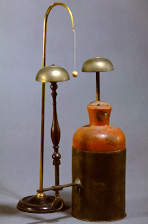
26 x 17.3 x 10
INDEX 1788 : P.III.554
Phialae trez crystallinae cilindricae, quarum una intus obducta est hydrargyro, quae operitur cera sigillatoria, in qua inest Pedunculus ex orichalco cum cochlea, et Catenula. Haec catenula phialam ingreditur: cum cochlea conjungi potest conductor Machinae, quae 532 describitur, inservitque ostendendae differentiae inter electricitatem negativam et positivam.
Three cylindrical crystal bottles, one of which is coated inside with mercury, which is closed with sealing wax, in which there is a small brass stem with a screw and chain. The chain goes inside the bottle: the conductor of the machine described in 532 can be joined to it with a screw; it is used to show the difference between negative and positive electricity.
Brass, iron and wood
This electrostatic bell is fundamentally, a Leyden jar. It has a brass external conductor with a horizontal rod attached to it. A small wooden column, with a bell fixed to its top, rises vertically from this rod. A metal rod emerges from the bottle, also topped by a bell, at the same level as the first one.
The Leyden bottle must be electrically charged before the experiment is carried out. This is done by connecting the internal shield to an electrostatic machine, and the external one to the ground. They are then disconnected and the bottle is electrically charged.
A pendulum made from a metal ball is suspended between the two bells, initially without charge. It is attracted to the bell on the jar and, on touching it, the ball is charged with the same charge, causing a repulsion effect which makes it strike the other bell. The successive contacts result in charge transfer from one shield to the other, the oscillating pendulum acting as the charge transporter.
This experiment needs very low humidity to be performed successfully, and then the pendulum movement and charge transfer can continue for hours.
From Colégio dos Nobres, catalogue n.º 536.
Sigaud de la Fond, Joseph-Aignan, Description et Usage d'un Cabinet de Physique Expérimentale, 1775, Vol. II, Pl. XXV, Fig. 1.
Wincker, M. F. H., Essai sur l'Electricité, 1748, Vol. III, Fig. 6.